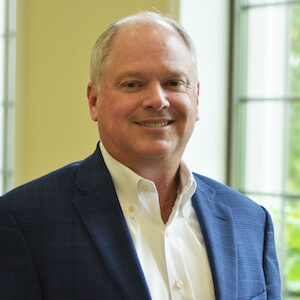Blog
Beyond Fundraising: Why Philanthropy is the Key to Catholic School Sustainability
 William J. Acton, Senior Partner at Advancement Partners
William J. Acton, Senior Partner at Advancement Partners

Money does not make a school great, but you can't have a great school without money. The answer is not fundraising. It's philanthropy. And a willingness to fund it.
"Money does not make a school great, but you can't have a great school without money."
And with that simple sentence, coined by the late Father Theodore Hesburgh early in his tenure as the president of the University of Notre Dame, we have the ideal strategic vision for every Catholic school in the country.
Every Catholic school spends plenty of time and energy talking or thinking about money. But often not in the right way. They are always trying to cut corners…save money…get things for less. Really putting a value on money and prioritizing funding…understanding where money fits into school operations and strategic thinking…thinking about money the "right" way…that's not something most Catholic schools do well.
Catholic schools and their complicated relationship with money go a long way back – to their founding by so many dedicated religious. The sisters, brothers and priests who started Catholic schools around the world were genuine heroes. Their commitment to mission, matched with their vows of poverty and humility (among other vows), drove them to welcome and educate all – regardless of financial means. Even children from affluent families benefited from reasonably priced education. And, in the earlier eras of big families, Catholic schools offered big families additional discounts for second, third, fourth and more siblings. As one of eight children, I was from one of those big families. By the time most of my younger siblings were enrolled at Saint Francis Xavier, the final couple of kids were going for free.
What kind of a goofy funding model did these religious establish? They "priced" their service – education – below cost! With school faculty primarily religious, who lived frugally and took vows of poverty, and whose mission was supported by parishes that balanced the books with offertory donations, the model worked. Plus, those priests, nuns and brothers weren't worried about putting 50 or so kids into each classroom. The economies of scale allowed for economic sustainability.
But even then there was a funding gap. To help with that there was bingo. And rummage sales. I remember the annual Saint Francis Xavier rummage sale vividly. Each school family would gather unwanted clothes and household items to donate to the school for the sale. We emptied our closets of clothes we had grown out of, cabinets of unmatched plates and mugs, and all sorts of odds and ends my parents didn't want and that we could bring to the good Sisters of Providence at the school to review and price for the one-day sale.
Come the day of the sale, the teachers let school out a little early so all the kids could walk through the sale, pockets stuffed with coins and the odd dollar bills, buying up a variety of treasured items that just days before were someone else's junk. That's right: we emptied our houses of our unwanted stuff, then bought someone else's unwanted items at the sale to bring back to our homes… to re-donate next year. And the school made money to patch up its funding hole. There were no fundraising expenses in this model! The rummage sale was the ideal fundraising event of the 1960s! Except, of course, none of them ever raised enough to renovate bathrooms or build additional gyms or update science labs – all things the religious educators decided could wait for another generation – ours – to deal with.
Times changed and costs soared. Our educators no longer live in a community with a vow of poverty. Classrooms aren't packed with 50 kids each. Parish collection baskets are much emptier, Church attendees fewer and overall parish expenses – beyond the school – have increased. Buildings are older, families are smaller, the pool of prospective students smaller – and much different. Things are crunched financially.
But some things haven't changed. Most Catholic schools still underprice their service. They still lose money on every full-tuition paying child that enrolls, although the gap between tuition and real cost is much bigger now. On top of that, schools must reduce the underpriced tuition even further for a large percentage of students who could not – or will not – pay full tuition.
But the fundraising mindset – and the awkward relationship with money – really hasn't changed much. Rather than studying the funding model and the financial needs of the school, schools embark on a patchwork, chaotic system of funding various pieces of school operations. There may no longer be rummage sales. Now we get things like Chick-fil-A night to benefit the band – with a net in the hundreds of dollars for our school band and thousands of dollars for Chick-fil-A. Or we have our Athletic Boosters selling wrapping paper, which everyone could buy for less at the Dollar Store. Doing so would give every family more money to pay tuition or donate to the school. Getting rid of these sales would also allow our middle schoolers to actually just talk to grandma and grandpa about their day and not be forced to ask them to buy overpriced paper.
This ad hoc, catch-as-catch-can fundraising mindset does not allow us to pay the teachers better. Or reduce tuition. Or improve programs or facilities. And too often we are just having different areas of the school competing with other areas of the school for the same dollar. We may be fundraising for new sports uniforms or to help fund the Math Team's trip to Walla Walla. But we are not improving our school, sustaining our mission or securing our future.
The increased financial headwinds today put a priority on funding. The costs of running a great school are growing exponentially. Attracting, retaining and rewarding the very best faculty – which you need in a school that "charges" tuition, by the way – is more challenging and expensive than ever. Programs cost more, facilities need upgrading and expectations of students and parents increase evermore.
There is no way, in this environment, to fundraise your way to greatness. Most of the time, the costs to raise money – sometimes hidden, sometimes not – are waaaaay more than anyone realizes. It is typical to spend 50 cents to raise one dollar for most fundraising activities. And that's without adding in the "hidden" costs. Let's take a look at one common fundraising example: the ubiquitous golf outing. If we put on a golf outing that grosses $100,000…we then have to pay the golf course (for the round of each golfer and the cart), the caterer (for the dinner and the boxed lunch) and the bar (for the two free drink tickets) and the postage and the postcards we mailed and…you get the picture. If we are finding sponsors to underwrite some of those costs, that money is going to the golf course and NOT advancing our school.
Then there are the hours and hours of time preparing, organizing, recruiting volunteers, setting up, cleaning up, gathering swag bags and raffle items.
And then there's the lost revenue when the local bank "holds back" a bit on their golf sponsorship since they know the Alumni Association and the ski team and Theater Boosters will also be looking for an ad from them. Add it all up and that $100,000 nets you maybe $50,000 – plus all of the lost opportunity to generate so much more if the personnel time had been more strategically allocated.
The answer is not fundraising. It's philanthropy. And a willingness to fund it. Schools need to prioritize fundraising that funds their mission. Their future depends on building a funding model that is long-term sustainable and the only two ways to do that, in a world where increased tuition has a cap, are (1) philanthropy and (2) endowment.
Major gifts, planned gifts. Stakeholders with giving potential. It's amazing to me that schools don't get this. They will not fully embrace philanthropy and what it can do for them. They will not invest in it. It will cost 50 cents to raise a dollar for most fundraising events like galas and golf outings and restaurant days. It will cost maybe 5 or 6 cents to raise a major gift dollar. That's the data.
But schools will hire an "events coordinator" before they hire a "major gifts officer." They won't invest in advancement marketing videos and materials because "they cost too much." They won't pay for prospect research. And they could never spend as much as $250,000 to execute a campaign that will raise them...wait for it...millions.
If I said, "Give me a nickel and I will give you a dollar in exchange," I bet I'd have a line down the block in a second. But tell that to a Catholic school and many will say, "No thanks. We'll just get the Dad's Club to staff the snack shop at football games. That doesn't cost us anything."
Schools who aren't investing in a philanthropic culture won't be around in 10 years or so. Schools that have assertively invested in capital campaigns and major gifts and planned giving programs these past several years are seeing real benefits as we witness the enormous transfer of wealth occurring in this country right now. There is over $260 billion sitting in donor advised funds across this country right now...with that figure probably doubling over the next several years. That $260+ billion – already gifted by the way – is waiting for the right cause, the "right" ask. But will schools pay to research their database to learn who in their community might have that kind of transformational potential?
You can NOT have a great school without money. Please remember Father Hesburgh's declaration. The religious who staffed our great schools in the 50s-70s were living endowments of the times. Thank God for their generosity! We have a responsibility to steward their legacy and the only way we can do that is to get with it and get comfortable with investing in our schools' futures.
Posted on: May 19, 2025
